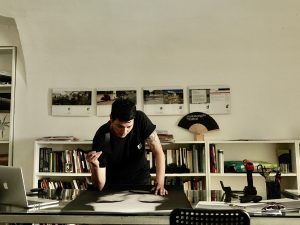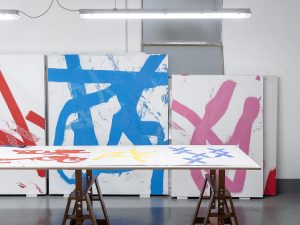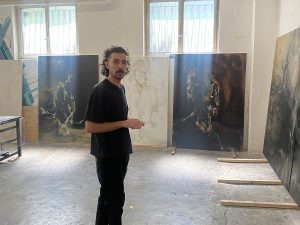‘Fools lament the decay of criticism.
For its day is long past.
Criticism is a matter of correct distancing.
It was at home in a world where perspectives and prospects counted
and where it was still possible to adopt a standpoint.
Now things press too urgently on human society’.[1]
Walter Benjamin
The relationship between artists and criticism has historically been founded on the principles of distance, detachment, and the space smaintained in-between. Historically, art criticism as a practice took the responsibility of analysing, studying, interpreting, and decoding a given context. Art history, philosophy and literature were seamlessly intertwined in the attempt to outline, compose, or configure an exegetical reading of reality. Here, the research and the various representations or codifications produced by artists were investigated and conveyed almost exclusively by way of the written word. In this perspective, it became almost impossible to understand the meaning and the importance of artistic feats and movements without considering the critical literature that took them as its point of reference. In light of these assumptions, the main role of criticism would appear to consist of mediating, i.e. bridging the gap between artists and the public, i.e. between the producers and the users of artistic values. Criticism thus becomes an extension — a tentacle — with which art attempted to hook itself onto society.
However, recently two major problems have emerged in the history of criticism. The first concerns its very status: If we accept that criticism has a primarily explanatory and popularising function, we are left unable to explain its position as a scientific subject or, in other cases, as a literary genre that resorts to often enigmatic ways of reasoning. Its use of a technical language, abundant with specialist nomenclatures and hermetics,[2] in fact makes it paradoxically less accessible than the figurative text to which it refers. The second issue instead has to do with the assimilation of criticism to the idea of ‘panning’. Which is to say, analysing content is confused with the bid to tear apart a given form or perspective, on the basis of a personal, subjective judgement devoid of any systemic framing. Venom, sarcasm, pungent commentary, and implacable prose ought to make peace with rigour, contextualisation, and some minimum of objectivity. We need only remember how Baudelaire invited those who deemed his words overly caustic to reread Diderot’s Salons, where the great philosopher, upon being recommended a painter who had many mouths to feed, argued that either paintings or the family needed abolishing.
It is, surely, paradoxical for a theoretical discipline not to enjoy scientific status (insofar as it lacks a collective body of verification or consensus on processes, norms and an idea of cognitive progress, and its decoding function thereby often becomes the self-entrenchment of those who already possess its interpretative codes, thus excluding a broader public). This has led criticism into an increasingly isolated, marginal, exclusive and ineffective position with respect to its foundational assumptions. One only has to compare the well-known exchanges between Francesco Arcangeli and Cesare Brandi or, later, the ones between Germano Celant and Achille Bonito Oliva in the national media, with the more recent debates confined almost entirely to the specialist press, to realise how art, up until the 1980s, occupied a much more prominent place in news media than it does today, and how any present-day theoretical debate has lost its incisiveness with respect to the interests of the public which it is supposed to address.
In this context, the principles mentioned at the beginning of this article — distance, detachment, and space kept in-between — have gradually turned into a clear watershed between criticism and society, with few interstices of possibility. This rift continues to widen, albeit with a few exceptions capable of re-founding expectations and succeeding in embarking on a path that has over the years dissipated in the fog of self-referentiality. Or indeed, vanished into the darkness caused by economic interests, the dynamics of self-promotion, relations of convenience, or the search for consensus.
If we look at the exemplary figures in the Italian art criticism of the last century such as Longhi, Carluccio, Tassi, Marchiori, Venturi and Argan, and then get to the more recent Carandente, Lonzi, Boatto, Menna, Calvesi, Crispolti, Fagiolo dell’Arco, Vergine or Barilli, we see that a certain sense of nostalgia and melancholy is making headway. Which is to say, nostalgia and melancholy for meticulous language, for the ability to work alongside artists without the presumption of towering over them, and for the need for distance — an indispensable element in maturing a free judgement. However, we must also recognise that the mode of relations between critic and artist has changed, indeed drastically so. We have seen the emergence of the militant critic, who analysed the meaning of the work side by side with the artist, becoming a ‘fellow traveller’. But above all we have witnessed the emergence of the curator as an epoch-making trend in criticism, founded precisely on the paradigm of proximity and interoperability with the artist. This tendency toward complicity — justified by an affinity of urges and problems, or by the sharing of a certain economic, political and social context — would still seem to contrast today with an obstinate and nostalgic criticism of dissent, based on distance and perspective as fundamentalelements of its legitimacy. Which is to say, a criticism holding that its arguments, expressions and formulations must categorically avoid a proximity that could compromise judgement, interpretation and its own epistemological mission.
From this perspective, everything would lead us to suggest that nostalgia, melancholy, and a gaze exclusively turned to the past are decisive elements for those who still maintain the need for distance, as if suffering from hypermetropia. If we reflect on how radically all relational and interpersonal systems have changed, or on how the Internet, social mediaor the way we connect have inevitably destroyed any previous paradigm, and if we accept how the speed and ease with which people can be reached determines every personal or professional relationship, then we cannot ignore the fact that the conception of criticism itself needs to be reviewed, perhaps avoiding a feeling of melancholy with respect to a past that will never return. If, again, it is characteristic of contemporary art that it must belong to its own time and reflect it, how can we abstract ourselves from our own context, looking back to previous ones in search of coordinates that are now useless? Would it not be more appropriate to definitively accept the figure of the critic — admitting its multiple configurations without imposing received limitations, without academic snobbery, without dogmas to be respected and without prejudices on the ways or places in which she finds her own way of expressing herself?
Surely the most problematic and possibly suspect form that the critic takes is the curator. Their exponential spread in recent decades[3] (often superficial,[4] improvised and lacking in-depth training) has not helped to achieve a widespread consensus on their role, which remains too ambiguous and lacking in recognisable connotations.[5] We often see projects in which the curator seems to play the role of organiser, sponsor or promoter rather than critic. We rarely see exhibitions that attempt to take stock of a particular phenomenon and even fewer projects in which the entire work of the artists involved is investigated. With this in mind, the core of the issue could and should be connected to the need to configure guidelines for exhibition writing, in order to seek greater critical complexity, and define once and for all the role of the curator as she who has to critically ‘tackle’ an exhibition.
In this way, the exhibition would finally, concretely, become the context par excellence in which to write, substantiate, interpret, develop and formalise theories and critical contents, starting from direct dialogue with the artists and the public response. This is surely a device that can be perfected, but it is also a dynamic one, agile but complex, established but renewable and, above all, a device that has the greatest potential in terms of the audience to be intercepted. It is an event that takes the form of ‘a happening with its own time and place, and that has the intrinsic capacity to capture, as if in a snapshot, the interests and issues that pervade its historical and geographical context’.[6] There is no shortage of examples of exhibitions that were disruptive with respect to the status quo ofthe system in which they appeared or, further, examples in which the very construction of an exhibition took on the form of an outright theoretical treatise on the artistic dynamics of the time. Going back over the last few decades, we can see how documenta 15 (2022), curated by the ruangrupa collective, questioned the neoliberal ideology of late capitalism, shifting the focus from the individual to the collective and working on regeneration, self-sufficiency, independence and resistance. Il Palazzo Enciclopedico (2013), the Biennale d’Arte di Venezia curated by Massimiliano Gioni, took the form of an exhibition of visual culture, through a project that addressed the function or dysfunction of the imagination and brought to the fore the inner life of the artist and his ability to produce stories and forms. The scientific, environmental and political arguments behind documenta 13 (2012), curated by Carolyn Christov-Bakargiev, contributed to a rethinking of the exploration and subsequent representation of contradiction by critically engaging with themes such as place, relocation or the specificity of cultures within a historical perspective. The exhibition Archive Fever: Uses of the Document in Contemporary Art (2008), curated by Okwui Enwezor at the International Center of Photography in New York, brought together the works of important contemporary artists who use archive material as a tool to rethink the meanings of identity, history, memory and loss. In Post Human (1992), at the FAE Musée d’Art Contemporain in Lausanne and then at the Castello di Rivoli, Jeffrey Deitch realised that something was changing and decided to substantiate it with an exhibition. Curated by Achille Bonito Oliva, Contemporanea (1973) is still considered one of the most important exhibitions of the 20th century, because of its international, interdisciplinary and multimedia character, while Vitalità del negativo nell’arte italiana 1960/70 (1970) transformed Rome’s Palazzo delle Esposizioni into a gigantic multimedia container. Information (1970) at theMoMA in New York, curated by Kynaston McShine, offered an international reportage on the artistic production by a new generation of artists getting to grips with mass media and what were then recent technological innovations. Finally, it is impossible not to mention Live in Your Head: When Attitudes Become Form (1969), curated by Harald Szeemann at the Bern Kunsthalle, considered one of the most emblematic and representative of all postwar exhibitions. A milestone in the artistic practices of its time, it is still used today as a prototype of an exhibition operating outside of the classical canons. Or we could mention Arte povera più azioni povere (1968), curated by Germano Celant in the ancient arsenals of Amalfi, a foundational step in the movement that renewed the artistic practice and imaginary of 1960s Italy, within an international perspective.
Of course this is not an exhaustive list of examples. But from them it can be readily deduced that ‘critical distance’ is, in fact, an enigma,[7] a fixation, an aprioristic stance and a nostalgia for dynamics handed down from the past. It is clear from these examples that the true enigma of the subject with respect to its own critical theory cannot still depend on an intellectual distance with respect to the object. After all, we know — as modernist and postmodernist theories have made us aware — that this distance is destined to disappear, regardless of those who still insist on keeping it alive. When the exhibition is accepted, conceived, and realised as a critical device, it takes the form of an inclusive site of enquiry that acts as a cultural mediator and becomes an activator and sounding board of the present, for the collective that it addresses.
[1] W. Benjamin,‘One Way Street’ in Selected Writings: 1913-1926, Vol. I, Cambridge, MA, Belknap Press, 1996.
[2] T. De Mauro, Il Linguaggio della critica d’arte, Firenze, Vallecchi, 1965.
[3] G. Romano, Become a curator, Milano, postmedia books, 2019.
[4] M. Perniola, L’arte e la sua ombra, Torino, Einaudi, 2000.
[5] D. Balzer, Curationism: How Curating Took Over the Art World and Everything Else, London, Pluto Press, 2015.
[6] A. Troncone, La dematerialalizzazione dell’arte in Italia, 1967-1973, Milano, postmedia books, 2014.
[7] H. Foster, The Return of the Real, Cambridge, (MA), MIT Press, 1996.





